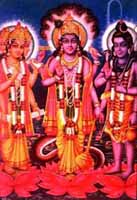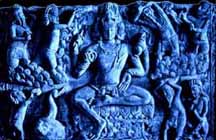Brahma, Vishnu, and Shiva. Creator, Preserver, Destroyer
In Hinduism the triad is not worshipped as such. Of its three members, Brahma, who was initially worshipped on the same level as the other two, evolved in the course of centuries into a somewhat unilateral and lesser god.
He stands for all practical purposes on a somewhat lower level than the two other members of the triad, and his worshippers have become steadily fewer in number.
The triad nowadays is no longer necessarily completed with Brahma, but with the the Great Goddess who, slowly but steadily, seems to push him aside. The three main gods worshipped today in India are Vishnu, Shiva and the Great Goddess who goes by many different names.
Brahma, on the left, rose out of the Egg of the Universe. In popular tradition and imagery, he is represented as coming forth from a lotus flower, growing out of the navel of Vishnu, depicted in the center. Brahma exclusively personifies creation and he is never said to destroy what he has created. He has, therefore, a one sided character.

